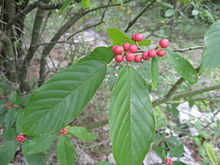Frangula caroliniana
| Frangula caroliniana | |
|---|---|

| |
| Scientific classification | |
| Kingdom: | Plantae |
| Clade: | Tracheophytes |
| Clade: | Angiosperms |
| Clade: | Eudicots |
| Clade: | Rosids |
| Order: | Rosales |
| Family: | Rhamnaceae |
| Genus: | Frangula |
| Species: | F. caroliniana
|
| Binomial name | |
| Frangula caroliniana | |

| |
| Generalized natural range of Frangula caroliniana | |
| Synonyms[2] | |
| |
Frangula caroliniana, commonly called the Carolina buckthorn,[3] is a deciduous upright shrub or small tree native to the southeastern, south-central, and mid-western parts of the United States, from Texas east to Florida and north as far as Maryland, Ohio, Missouri, and Oklahoma.[4] There is also an isolated population in the State of Nuevo León in northeastern Mexico.[5] It is found in a wide variety of habitats, including barrens, forests, and limestone bluffs.[6]
Description
[edit]Frangula caroliniana is usually around 12 to 15 feet (3.7 to 4.6 meters) high, but capable of reaching 40 feet (12 meters) in a shaded location.[7] The most striking characteristic of this plant are its shiny, dark green leaves. The flowers are very small and inconspicuous, pale yellow-green, bell-shaped, appearing in leaf axils in late spring after the leaves. The fruit is a small (1/3 inch or 8.3 mm) round drupe; at first red, but later turning black with juicy flesh. It ripens in late summer.[8]
Despite its common name, the Carolina buckthorn is completely thornless.
-
Frangula caroliniana in bloom
Ecology and uses
[edit]Wildlife such as songbirds eat the fruits, which are reported to have medicinal uses.[9]
References
[edit]- ^ IUCN SSC Global Tree Specialist Group.; Botanic Gardens Conservation International; et al. (BGCI) (2020). "Frangula caroliniana". IUCN Red List of Threatened Species. 2020: e.T152857979A152907018. doi:10.2305/IUCN.UK.2020-1.RLTS.T152857979A152907018.en. Retrieved 19 November 2021.
- ^ Tropicos, Rhamnus caroliniana Walter
- ^ USDA, NRCS (n.d.). "Frangula caroliniana". The PLANTS Database (plants.usda.gov). Greensboro, North Carolina: National Plant Data Team. Retrieved 9 January 2018.
- ^ Biota of North America Program 2014 county distribution map
- ^ "Rhamnus caroliniana Range Map" (PDF). United States Geological Survey. Retrieved 2009-07-07.
- ^ Flora of North America Frangula caroliniana
- ^ "Rhamnus caroliniana Carolina Buckthorn" (PDF). University of Florida. Retrieved 2009-07-07.
- ^ "Fragula caroliniana Fact Sheet (Virginia Tech)". Archived from the original on 2009-05-05. Retrieved 2009-07-07.
- ^ Little, Elbert L. (1980). The Audubon Society Field Guide to North American Trees: Eastern Region. New York: Knopf. p. 594. ISBN 0-394-50760-6.


